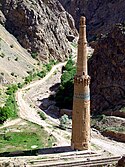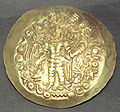Kushano-Sasanian Kingdom

The Kushano-Sassanids (also called Kushanshas or Indo-Sassanians) were a branch of the Sassanid Persians who established their rule in Bactria and in northwestern Indian subcontinent (present day Pakistan) during the 3rd and 4th centuries at the expense of the declining Kushans. They captured the provinces of Sogdiana, Bactria and Gandhara from the Kushans in 225 CE.[2] The Sasanians established governors for the Sasanian Empire, who minted their own coinage and took the title of Kushanshas, i.e. "Kings of the Kushans".[2] They are sometimes considered as forming a "sub-kingdom" inside the Sasanian Empire.[3] This administration continued until 360-370 CE,[2] when the Kushano-Sasanians lost their territories to the invading Kidarite Huns.[3] Thereafter the limit of Sasanian territory was near Merv.[3] Later, the Kidarites were in turn displaced by the Hephthalites.[4] The Sasanians were able to re-establish some authority after they destroyed the Hephthalites with the help of the Turks in 565, but their rule collapsed under Arab attacks in the mid 7th century.
The Kushanshas are mainly known through their coins. Their coins were minted at Kabul, Balkh, Herat, and Merv, attesting the extent of their realm.[1]
A rebellion of Hormizd I Kushanshah (277-286 CE), who issued coins with the title Kushanshahanshah ("King of kings of the Kushans"), seems to have occurred against contemporary emperor Bahram II (276-293 CE) of the Sasanian Empire, but failed.[2]
Contents
History
First Kushano-Sassanid period
The Sassanids, shortly after victory over the Parthians, extended their dominion into Bactria during the reign of Ardashir I around 230 CE, then further to the eastern parts of their empire in western Pakistan during the reign of his son Shapur I (240–270). Thus the Kushans lost their western territory (including Bactria and Gandhara) to the rule of Sassanid nobles named Kushanshahs or "Kings of the Kushans".

The Kushano-Sasanians under Hormizd I Kushanshah seem to have led a rebellion against contemporary emperor Bahram II (276-293 CE) of the Sasanian Empire, but failed.[2] According to the Panegyrici Latini (3rd-4th century CE), there was a rebellion of a certain Ormis (Ormisdas) against his brother Bahram II, and Ormis was supported the people of Saccis (Sakastan).[1] Hormizd I Kushanshah issued coins with the title Kushanshahanshah ("King of kings of the Kushans"),[5] probably in defiance of imperial Sasanian rule.[2]
Around 325, Shapur II was directly in charge of the southern part of the territory, while in the north the Kushanshahs maintained their rule until the rise of the Kidarites.
The decline of the Kushans and their defeat by the Kushano-Sassanids led to the rise of the Kidarites and then the Hephthalites who conquered Bactria and Gandhara, thus replacing the Kushano-Sassanids, until the arrival of Islam to Pakistan.
Second Kushano-Sassanid period

The Hephthalites dominated the area until they were defeated in 565 AD by an alliance between the Gokturks and Sassanids, and some Indo-Sassanid authority was re-established. The Kushano-Hephthalites were able to set up rival states in Kapisa, Bamiyan, and Kabul. The 2nd Indo-Sassanid period ended with the collapse of Sassanids to the Rashidun Caliphate in the mid 7th century. Sind remained independent until the Arab invasions of India in the early 8th century. The Kushano-Hephthalites or Turkshahis were replaced by the Shahi in the mid 8th century.
Religious influences

Obv: King Varhran I with characteristic head-dress.
Rev: Shiva with bull Nandi, in Kushan style.
Coins depicting Shiva and the Nandi bull have been discovered, indicating a strong influence of Shaivite Hinduism.[7]
The prophet Mani (210–276 CE), founder of Manichaeism, followed the Sassanids' expansion to the east, which exposed him to the thriving Buddhist culture of Gandhara. He is said to have visited Bamiyan, where several religious paintings are attributed to him, and is believed to have lived and taught for some time. He is also related to have sailed to the Indus valley area now in modern-day Pakistan in 240 or 241 CE, and to have converted a Buddhist King, the Turan Shah of India.[8]
On that occasion, various Buddhist influences seem to have permeated Manichaeism: "Buddhist influences were significant in the formation of Mani's religious thought. The transmigration of souls became a Manichaean belief, and the quadripartite structure of the Manichaean community, divided between male and female monks (the 'elect') and lay follower (the 'hearers') who supported them, appears to be based on that of the Buddhist sangha"[8]
Artistic influences
The Indo-Sassanids traded goods such as silverware and textiles depicting the Sassanid emperors engaged in hunting or administering justice. The example of Sassanid art was influential on Kushan art, and this influence remained active for several centuries in the northwest South Asia.
Main Kushano-Sassanid rulers

Based on coinage, a list of the Kushanshah rulers can be established:[9][10]
- Ardashir I Kushanshah (230-?)
- Ardashir II Kushanshah (?-245)
- Peroz I Kushanshah (245-270)
- Hormizd I Kushanshah (270-295), rebelled against Bahram II of Iran.[2]
- Hormizd II Kushanshah (295-300)
- Peroz II Kushanshah (300-325)
- Varahran I Kushanshah (325-350), also named Bahram
- Varahran II Kushanshah (360)[11]
- Peroz III Kushanshah (350-360) in Gandhara.[12][13]
Coinage
| Wikimedia Commons has media related to Kushano-Sasanian Kingdom. |
The Kushano-Sassanids created an extensive coinage with legend in Brahmi, Pahlavi or Bactrian, sometimes inspired from Kushan coinage, and sometimes more clearly Sassanid.
The obverse of the coin usually depicts the ruler with elaborate headdress and on the reverse either a Zoroastrian fire altar, or Shiva with the bull Nandi.
-
Ardashir I Kushanshah in the name of Kushan ruler Vasudeva I, circa 230-245 CE.[14]
-
Hormizd I Kushanshah with mention of Mazda and Anahita. Merv mint.[5]
See also
|
Part of a series on the
|
|---|
| History of Afghanistan |
 |
| Timeline |
| Associated Historical Regions |
| Outline of South Asian history |
|---|
'박트리아·쿠샨·사산왕조' 카테고리의 다른 글
| <펌>박트리아 - 위키 (0) | 2019.08.22 |
|---|---|
| <펌> 페르시아 제국 - 위키백과 (0) | 2019.07.11 |
| <펌>파르티아 (BC 247 - AD 224) (0) | 2019.05.24 |
| <펌> 쿠샨제국 (AD 30-AD225)- 위키백과 (0) | 2019.05.24 |
| <펌>사산왕조(AD 226-AD651) -나무위키 (0) | 2019.05.24 |





